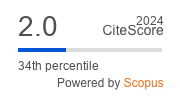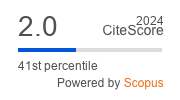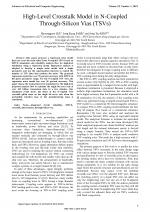| 3/2018 - 2 |
High-Level Crosstalk Model in N-Coupled Through-Silicon Vias (TSVs)LEE, H. |
| Extra paper information in |
| Click to see author's profile in |
| Download PDF |
Author keywords
integrated circuit reliability, SPICE, crosstalk, interconnect, through-silicon via
References keywords
design(13), systems(7), silicon(6), integration(6), integrated(6), circuits(6), chip(6), vias(5), technology(5), modeling(5)
Blue keywords are present in both the references section and the paper title.
About this article
Date of Publication: 2018-08-31
Volume 18, Issue 3, Year 2018, On page(s): 9 - 14
ISSN: 1582-7445, e-ISSN: 1844-7600
Digital Object Identifier: 10.4316/AECE.2018.03002
Web of Science Accession Number: 000442420900002
SCOPUS ID: 85052155428
Abstract
This paper proposes a regression noise model that can cover the noise effect from N-coupled TSVs based on SPICE simulation and reliability analysis flow for high-level simulation using a regression model. Regression analysis is adopted to develop a simple noise model with a single parameter and use the superposition theorem to extend the number of TSV lines that produce the noise. The proposed regression model has over 99 percent accuracy with SPICE in the given parameter range. For the N-coupled TSV wire, the regression noise model has over 96 percent accuracy. This paper choose the transaction level simulation for the high-level proposed analysis flow to calculate the single bit error rate of over 100 billion transaction data in a few minutes. Our simulation result shows the effect of the N-coupled TSV crosstalk glitch noise on the single bit error rate when the probability function type of the manufacturing noise is considered. |
| References | | | Cited By «-- Click to see who has cited this paper |
| [1] S. Borkar, "Design challenges of technology scaling," IEEE micro, vol. 19, no. 4 pp. 23-29, 1999. [CrossRef] [Web of Science Times Cited 622] [SCOPUS Times Cited 850] [2] M. Swaminathan, et al, "Power integrity modeling and design for semiconductors and systems," Pearson Education, 2007. [CrossRef] [3] Y. Zhang, et al, "Prediction and comparison of high-performance on-chip global interconnection," IEEE Transactions on Very Large Scale Integration (VLSI) Systems, vol. 19, no. 7, pp. 1154-1166, 2011. [CrossRef] [SCOPUS Times Cited 6] [4] Polka, Lesley Anne, et al, "Package Technology to Address the Memory Bandwidth Challenge for Tera-scale Computing," Intel Technology Journal, vol. 11, no. 3, 2007. [CrossRef] [5] R. Weerasekera, et al, "On signalling over through-silicon via (TSV) interconnects in 3-D integrated circuits," Proceedings of the Conference on Design, Automation and Test in Europe. European Design and Automation Association, pp. 1325-1328, 2010. [CrossRef] [SCOPUS Times Cited 23] [6] K. Banerjee, et al, "3-D ICs: A novel chip design for improving deep-submicrometer interconnect performance and systems-on-chip integration," Proceedings of the IEEE, vol. 89, no. 5, pp. 602-633, 2001. [CrossRef] [Web of Science Times Cited 749] [SCOPUS Times Cited 877] [7] Z. Xu, A. Beece, et al, "Crosstalk evaluation, suppression and modeling in 3D through-strata-via (TSV) network," 3D Systems Integration Conference (3DIC), 2010 IEEE International. IEEE, pp. 1-8, 2010. [CrossRef] [SCOPUS Times Cited 41] [8] S. K. Lim, "Design for high performance, low power, and reliable 3D integrated circuits," Springer Science & Business Media, 2013. [CrossRef] [SCOPUS Times Cited 35] [9] J. Q. Lu, "3-D Hyperintegration and Packaging Technologies for MicroNano Systems," Proceeding of IEEE, Vol. 97, no. 1, pp. 18-30, Jan. 2009. [CrossRef] [Web of Science Times Cited 270] [SCOPUS Times Cited 310] [10] R. S. Patti, "Three-Dimensional Integrated Circuits and the Future of System-on-Chip Designs", Proceedings of IEEE, vol. 94, no. 6, pp. 1214-1224, June 2006. [CrossRef] [Web of Science Times Cited 444] [SCOPUS Times Cited 544] [11] Q. Wu, K. Rose, J. Q. Lu, T. Zhang, "Impacts of Though-DRAM Power Vias in 3D Processor-DRAM Integrated Systems," IEEE International 3D System Integration Conference, San Francisco, CA, 2009. [CrossRef] [SCOPUS Times Cited 18] [12] K. C. Saraswat, F. Mohammadi, "Effect of Interconnection Scaling on Time Delay of VLSI circuits," IEEE Trans. Electron Devices, Vol. 29, pp. 645-50, 1982. [CrossRef] [SCOPUS Times Cited 74] [13] T. Song, et al, "Analysis of TSV-to-TSV coupling with high-impedance termination in 3D ICs," Quality Electronic Design (ISQED), 2011 12th International Symposium on. IEEE, pp. 1-7, 2011. [CrossRef] [SCOPUS Times Cited 31] [14] L.Cadix, et al, "Integration and frequency dependent electrical modeling of Through Silicon Vias (TSV) for high density 3DICs," Interconnect Technology Conference (IITC), 2010 International. IEEE, pp. 1-3, 2010. [CrossRef] [SCOPUS Times Cited 21] [15] I. Savidis, Eby G. Friedman, "Closed-form expressions of 3-D via resistance, inductance, and capacitance," IEEE Transactions on Electron Devices, vol. 56, no. 9, pp. 1873-1881, 2009. [CrossRef] [Web of Science Times Cited 142] [SCOPUS Times Cited 194] [16] R.Weerasekera, M. Grange, et al, "Compact modelling of through-silicon vias (TSVs) in three-dimensional (3-D) integrated circuits." IEEE International Conference on 3D System Integration. pp. 1-8, 2009. [CrossRef] [SCOPUS Times Cited 95] [17] Z. Qiaosha, et al, "3DLAT: TSV-based 3D ICs crosstalk minimization utilizing Less Adjacent Transition code," Design Automation Conference (ASP-DAC), 2014 19th Asia and South Pacific, pp. 762-767, 2014. [CrossRef] [SCOPUS Times Cited 31] [18] C. Liu, et al, "Full-chip TSV-to-TSV coupling analysis and optimization in 3D IC," Proceedings of the 48th Design Automation Conference, pp. 783-788, 2011. [CrossRef] [SCOPUS Times Cited 93] [19] K. Yoon, et al, "Modeling and analysis of coupling between TSVs, metal, and RDL interconnects in TSV-based 3D IC with silicon interposer," Electronics Packaging Technology Conference, EPTC'09. 11th, pp. 702-706, 2009. [CrossRef] [Web of Science Times Cited 47] [SCOPUS Times Cited 71] [20] A. E. Engin, S. R. Narasimhan, "Modeling of crosstalk in through silicon vias," IEEE Transactions on Electromagnetic Compatibility, vol. 55, no.1, pp. 149-158, 2013. [CrossRef] [Web of Science Times Cited 87] [SCOPUS Times Cited 99] [21] D. Khalil, et al, "Analytical model for the propagation delay of through silicon vias" Quality Electronic Design, 2008. ISQED 2008. 9th International Symposium on, pp. 553-556, 2008. [CrossRef] [SCOPUS Times Cited 40] [22] Y. Eo, et al, "A new on-chip interconnect crosstalk model and experimental verification for CMOS VLSI circuit design," IEEE transactions on Electron Devices, vol. 47, no. 1, pp. 129-140, 2000. [CrossRef] [SCOPUS Times Cited 45] [23] K. Agarwal, et al, "Statistical interconnect metrics for physical-design optimization" IEEE Transactions on Computer-Aided Design of Integrated Circuits and Systems, vol. 25, no. 7, pp. 1273-1288, 2006. [CrossRef] [Web of Science Times Cited 97] [SCOPUS Times Cited 46] [24] J. Moreno, et al, "Low voltage testing for interconnect opens under process variations," Test Workshop (LATW), 2012 13th Latin American. IEEE, pp. 1-6, 2012. [CrossRef] [SCOPUS Times Cited 2] Web of Science® Citations for all references: 2,458 TCR SCOPUS® Citations for all references: 3,546 TCR Web of Science® Average Citations per reference: 98 ACR SCOPUS® Average Citations per reference: 142 ACR TCR = Total Citations for References / ACR = Average Citations per Reference We introduced in 2010 - for the first time in scientific publishing, the term "References Weight", as a quantitative indication of the quality ... Read more Citations for references updated on 2025-06-01 11:42 in 160 seconds. Note1: Web of Science® is a registered trademark of Clarivate Analytics. Note2: SCOPUS® is a registered trademark of Elsevier B.V. Disclaimer: All queries to the respective databases were made by using the DOI record of every reference (where available). Due to technical problems beyond our control, the information is not always accurate. Please use the CrossRef link to visit the respective publisher site. |
Faculty of Electrical Engineering and Computer Science
Stefan cel Mare University of Suceava, Romania
All rights reserved: Advances in Electrical and Computer Engineering is a registered trademark of the Stefan cel Mare University of Suceava. No part of this publication may be reproduced, stored in a retrieval system, photocopied, recorded or archived, without the written permission from the Editor. When authors submit their papers for publication, they agree that the copyright for their article be transferred to the Faculty of Electrical Engineering and Computer Science, Stefan cel Mare University of Suceava, Romania, if and only if the articles are accepted for publication. The copyright covers the exclusive rights to reproduce and distribute the article, including reprints and translations.
Permission for other use: The copyright owner's consent does not extend to copying for general distribution, for promotion, for creating new works, or for resale. Specific written permission must be obtained from the Editor for such copying. Direct linking to files hosted on this website is strictly prohibited.
Disclaimer: Whilst every effort is made by the publishers and editorial board to see that no inaccurate or misleading data, opinions or statements appear in this journal, they wish to make it clear that all information and opinions formulated in the articles, as well as linguistic accuracy, are the sole responsibility of the author.



